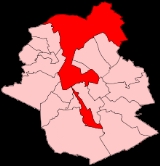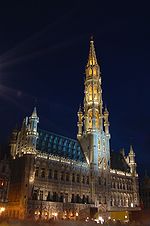
City of Brussels
Encyclopedia
The City of Brussels is the largest municipality
of the Brussels-Capital Region
, and the official capital
of Belgium by law.
Somewhat in the way that the City of London
is different from London
, the City of Brussels is different from Brussels
. However, the expansion of the City was frozen at a later stage than the City of London, so that in addition to the old centre of Brussels, the towns of Haren
, Laeken and Neder-Over-Heembeek
to the north, and Avenue Louise
and the Bois de la Cambre
park to the south, are included.
On 1 January 2006, the City of Brussels had a total population of 144,784. The total area is 32.61 km² which gives a population density
of 4,440 inhabitants per km². As of 2007, there were approximately 50,000 registered non-Belgians in the City of Brussels.
 At first, the City of Brussels was simply defined, being the area within the second walls of Brussels
At first, the City of Brussels was simply defined, being the area within the second walls of Brussels
, the modern-day small ring
. As the city grew, the surrounding villages grew as well, eventually growing into a contiguous city, though the local governments retained control of their area.
The construction of Avenue Louise
was commissioned in 1847 as a monumental avenue bordered by chestnut trees that would allow easy access to the popular recreational area of the Bois de la Cambre
. However, fierce resistance to the project was put up by the town of Ixelles (which was then still separate from Brussels) through whose land the avenue was supposed to run. After years of fruitless negotiations, Brussels finally annexed
the narrow band of land needed for the avenue plus the Bois de la Cambre itself in 1864. That decision accounts for the unusual southeastern protrusion of the City of Brussels and for Ixelles being split in two separate parts. The Université Libre de Bruxelles
' Solbosch campus is also part of the City of Brussels, partially accounting for the bulge in the southeast end.
Unlike most of the municipalities in Belgium, the ones located in the Brussels-Capital Region were not merged with others during mergers occurring in 1964, 1970, and 1975. However, several municipalities been merged with the City of Brussels throughout its history including Laeken, Haren
, and Neder-Over-Heembeek
, which were merged into the City of Brussels in 1921.
 As in every other Belgian municipality, the City of Brussels is headed by a mayor
As in every other Belgian municipality, the City of Brussels is headed by a mayor
, which should be confused with neither the Minister-President of the Brussels-Capital Region
nor the Governor of Brussels-Capital
.
Municipality
A municipality is essentially an urban administrative division having corporate status and usually powers of self-government. It can also be used to mean the governing body of a municipality. A municipality is a general-purpose administrative subdivision, as opposed to a special-purpose district...
of the Brussels-Capital Region
Brussels
Brussels , officially the Brussels Region or Brussels-Capital Region , is the capital of Belgium and the de facto capital of the European Union...
, and the official capital
Capital City
Capital City was a television show produced by Euston Films which focused on the lives of investment bankers in London living and working on the corporate trading floor for the fictional international bank Shane-Longman....
of Belgium by law.
Somewhat in the way that the City of London
City of London
The City of London is a small area within Greater London, England. It is the historic core of London around which the modern conurbation grew and has held city status since time immemorial. The City’s boundaries have remained almost unchanged since the Middle Ages, and it is now only a tiny part of...
is different from London
London
London is the capital city of :England and the :United Kingdom, the largest metropolitan area in the United Kingdom, and the largest urban zone in the European Union by most measures. Located on the River Thames, London has been a major settlement for two millennia, its history going back to its...
, the City of Brussels is different from Brussels
Brussels
Brussels , officially the Brussels Region or Brussels-Capital Region , is the capital of Belgium and the de facto capital of the European Union...
. However, the expansion of the City was frozen at a later stage than the City of London, so that in addition to the old centre of Brussels, the towns of Haren
Haren, Belgium
Haren is an old municipality of Brussels in Belgium, that was merged into the municipality of the City of Brussels in 1921...
, Laeken and Neder-Over-Heembeek
Neder-over-Heembeek
Neder-over-Heembeek is a northern part of the City of Brussels municipality in Belgium. It is a commune which lost its municipality status when it was merged with the City of Brussels....
to the north, and Avenue Louise
Avenue Louise
Avenue Louise or Louizalaan is a major thoroughfare in Brussels. It runs southeast from Louise Square to the Bois de la Cambre, covering a distance of .- History :...
and the Bois de la Cambre
Bois de la Cambre
Ter Kamerenbos or Bois de la Cambre is an urban public park on the edge of the Sonian Forest in Brussels, Belgium. It has an area of 1.23 square kilometres. The park lies in the south of the Brussels-Capital Region, and in the municipality of the City of Brussels...
park to the south, are included.
On 1 January 2006, the City of Brussels had a total population of 144,784. The total area is 32.61 km² which gives a population density
Population density
Population density is a measurement of population per unit area or unit volume. It is frequently applied to living organisms, and particularly to humans...
of 4,440 inhabitants per km². As of 2007, there were approximately 50,000 registered non-Belgians in the City of Brussels.
Territorial history

Second walls of Brussels
There were two stages of fortifications of Brussels, the first walls, built in the early 13th century, and the second walls, built in the late 14th century and later upgraded. Today, only a few sections of either remain.-First walls:...
, the modern-day small ring
Small ring (Brussels)
The Brussels small ring or inner ring road is a series of roadways in central Brussels, Belgium, surrounding the historic city centre. It was built on the site of the Second walls of Brussels, built in the 16th century, after they were torn down....
. As the city grew, the surrounding villages grew as well, eventually growing into a contiguous city, though the local governments retained control of their area.
The construction of Avenue Louise
Avenue Louise
Avenue Louise or Louizalaan is a major thoroughfare in Brussels. It runs southeast from Louise Square to the Bois de la Cambre, covering a distance of .- History :...
was commissioned in 1847 as a monumental avenue bordered by chestnut trees that would allow easy access to the popular recreational area of the Bois de la Cambre
Bois de la Cambre
Ter Kamerenbos or Bois de la Cambre is an urban public park on the edge of the Sonian Forest in Brussels, Belgium. It has an area of 1.23 square kilometres. The park lies in the south of the Brussels-Capital Region, and in the municipality of the City of Brussels...
. However, fierce resistance to the project was put up by the town of Ixelles (which was then still separate from Brussels) through whose land the avenue was supposed to run. After years of fruitless negotiations, Brussels finally annexed
Annexation
Annexation is the de jure incorporation of some territory into another geo-political entity . Usually, it is implied that the territory and population being annexed is the smaller, more peripheral, and weaker of the two merging entities, barring physical size...
the narrow band of land needed for the avenue plus the Bois de la Cambre itself in 1864. That decision accounts for the unusual southeastern protrusion of the City of Brussels and for Ixelles being split in two separate parts. The Université Libre de Bruxelles
Université Libre de Bruxelles
The Université libre de Bruxelles is a French-speaking university in Brussels, Belgium. It has 21,000 students, 29% of whom come from abroad, and an equally cosmopolitan staff.-Name:...
' Solbosch campus is also part of the City of Brussels, partially accounting for the bulge in the southeast end.
Unlike most of the municipalities in Belgium, the ones located in the Brussels-Capital Region were not merged with others during mergers occurring in 1964, 1970, and 1975. However, several municipalities been merged with the City of Brussels throughout its history including Laeken, Haren
Haren, Belgium
Haren is an old municipality of Brussels in Belgium, that was merged into the municipality of the City of Brussels in 1921...
, and Neder-Over-Heembeek
Neder-over-Heembeek
Neder-over-Heembeek is a northern part of the City of Brussels municipality in Belgium. It is a commune which lost its municipality status when it was merged with the City of Brussels....
, which were merged into the City of Brussels in 1921.
Mayors

Mayor
In many countries, a Mayor is the highest ranking officer in the municipal government of a town or a large urban city....
, which should be confused with neither the Minister-President of the Brussels-Capital Region
Minister-President of the Brussels-Capital Region
The Minister-President of the Brussels Capital-Region is the person leading the Government of the Brussels-Capital Region. The post is appointed for 5 years along with 4 ministers and 3 "state" secretaries...
nor the Governor of Brussels-Capital
Governor of Brussels-Capital
The Governor of the Administrative Arrondissement of Brussels-Capital has the responsibility to enforce laws concerned with public order in the Brussels-Capital Region, one of the three regions of Belgium. The governor's powers are actually quite limited...
.

